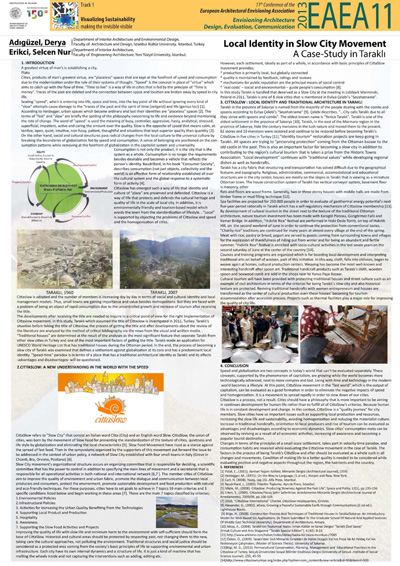11th EAEA Envisioning Architecture: Design, Evaluation, Communication Conference in 2013
Track 1 | Visualizing Sustainability - Making the invisible visible
Local identity in slow city movement: a case-study in Taraklı
Keywords: slow city movement (Cittaslow); local identity; traditional houses; speed
ABSTRACT
A greatest virtue of man's is establishing a city.
Plato
Cities, products of man's greatest virtue, are "placeless" spaces that are kept at the forefront of speed and consumption due to the modernization under the rule of their systems of thought. "Speed" is the concept in place of "virtue" which aims to catch up with the flow of time. "Time to live" is a way of life in cities that is fed by the principle of “Time is money”. Traces of the past are deleted and the connection between space and location are broken away by speed in city life. Cittaslow has emerged such a way of life that identity and culture of "place" are preserved and defended. "Local" is supported by objecting the problems of Cittaslow and speed and the homogenization of cities. Cittaslow is adopted and the number of members is increasing day by day in terms of social and cultural identity and local management models. Thus, small towns are gaining importance and value besides metropolitans. But they are faced with a problem of being an object of rapid consumption due to the uncontrolled growth and increase of tourism after receiving the title.
The developments after receiving the title are needed to inquire in a ciritical point of view for the right implementation of Cittaslow movement. In this study, Taraklı which assumed the title of Cittaslow is investigated in 2011,Turkey. Taraklı's situation before taking the title of Cittaslow, the process of getting the title and after developments about the review of the literature are analyzed by the method of critical bibliography via the news from the visual and written media. "Traditional houses" are determined at the result of the analyses as the most significant feature that seperates Taraklı from other slow cities in Turkey and one of the most important factors of getting the title. Traditional houses are examined in residential structure that is an important part of the traditional architecture. Taraklı has a "natural monument" state with its' wooden Ottoman houses, its' environment not being defeated by concrete and cobblestone streets. Taraklı made an application for UNESCO World Heritage List that has traditional houses during the Ottoman period.
In this study, the process of becoming a slow city of Taraklı was examined based on its traditional architectural identity. Observation and in-depth interviews method with the users of the houses were used in these investigations. In the end, the process of becoming a slow city of Taraklı was examined that defines a settlement against globalization at its core and has a predominant local identity. The traditional architecture will be analyzed by interpreting the space definiton with the cultural/historical structure and how to have a place in slow city movement. Location and meaning of the concepts such as space spirit/entity within the scope of this movement will be considered in traditional architecture of Taraklı. "Speed-time" paradox is in terms of a place that has a traditional architectural identity as Taraklı and its affects -advantages and disadvanteges- will be questioned.
AUTHORS
Derya Adıgüzel
Department of Interior Architecture and Environmental Design, Faculty of Art and Design, İstanbul Kültür University, İstanbul, Turkey, d.adiguzel@iku.edu.tr
Selcen Nur Erikci
Department of Interior Architecture, Faculty of Engineering-Architecture, Yeni Yüzyıl University, İstanbul, Turkey, selcennur.erikci@yeniyuzyil.edu.tr, selcen.erikci@gmail.com
